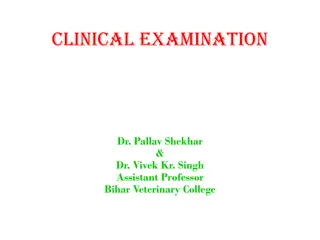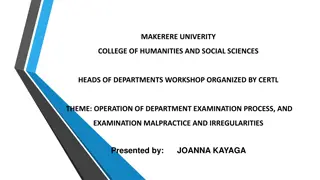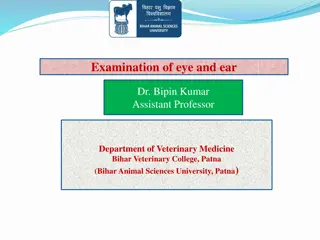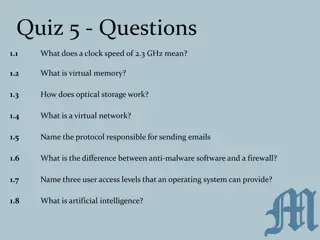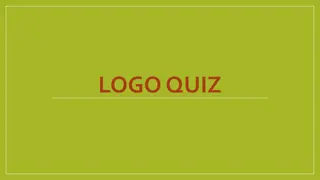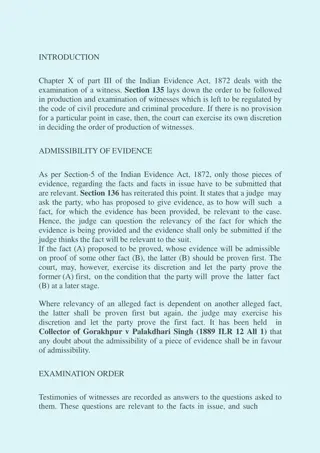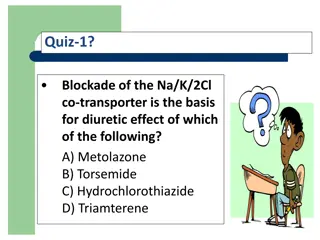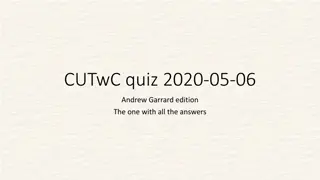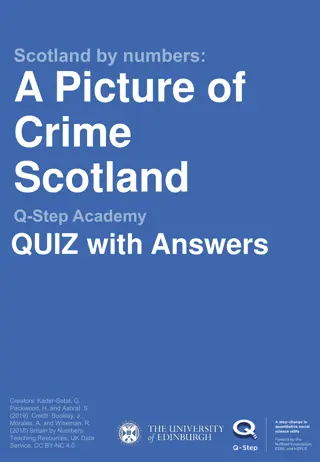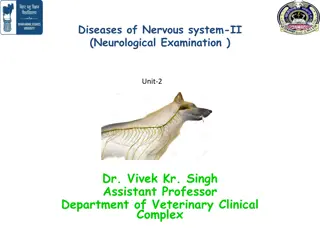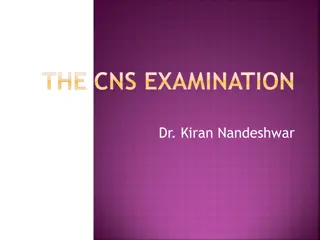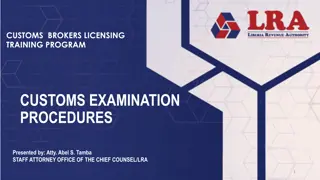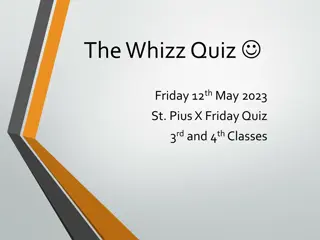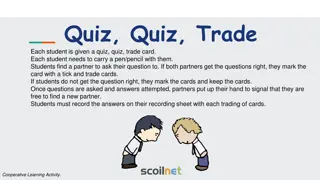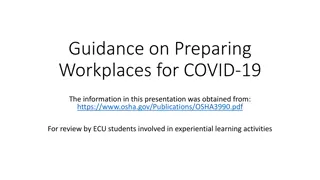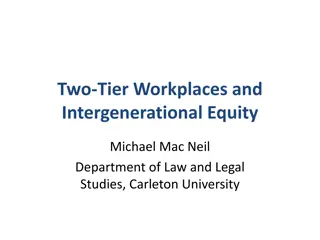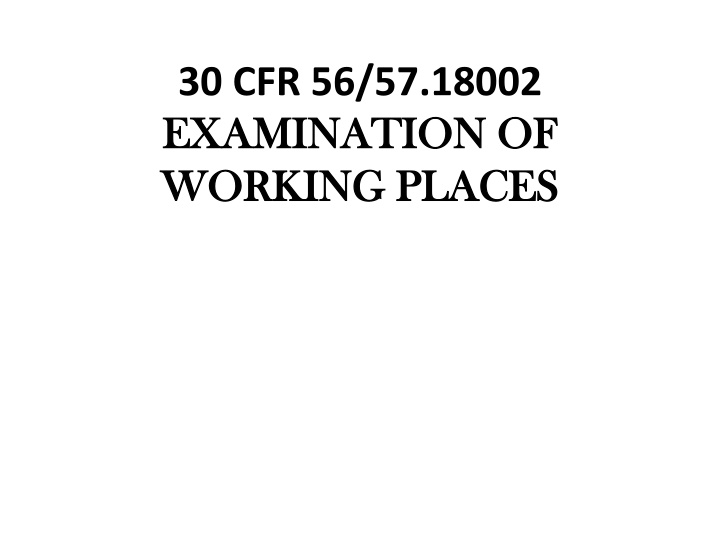
Workplace Safety Regulations and Examination Guidelines
Explore important workplace safety regulations and guidelines for conducting examinations of working places. Learn about record-keeping requirements, competencies needed, and the categories to include in a crushing screening plant's examination checklist. Ensure compliance and safety in mining operations.
Download Presentation

Please find below an Image/Link to download the presentation.
The content on the website is provided AS IS for your information and personal use only. It may not be sold, licensed, or shared on other websites without obtaining consent from the author. If you encounter any issues during the download, it is possible that the publisher has removed the file from their server.
You are allowed to download the files provided on this website for personal or commercial use, subject to the condition that they are used lawfully. All files are the property of their respective owners.
The content on the website is provided AS IS for your information and personal use only. It may not be sold, licensed, or shared on other websites without obtaining consent from the author.
E N D
Presentation Transcript
30 CFR 56/57.18002 EXAMINATION OF EXAMINATION OF WORKING PLACES WORKING PLACES
1. CFR 56.18002 is: a.) title 56 of the Code of Federal Regulations, b.) the standard requiring workplace examinations each workshift, c.) Part 56 of Title 30 of the Code of Federal Regulations. 2. Written workplace examination records must be kept for: a.) 1 week b.) until the MSHA inspector comes, c.) 1 month d.) 6 months e.) 1 Year f.) 5 Years
1. CFR 56.18002 is: a.) title 56 of the Code of Federal Regulations, b.) the standard requiring workplace examinations each workshift, c.) Part 56 of Title 30 of the Code of Federal Regulations. 2. Written workplace examination records must be kept for: a.) 1 week b.) until the MSHA inspector comes, c.) 1 month d.) 6 months e.) 1 Year f.) 5 Years
3. A workplace examination record must contain: a.) the examiner s signature, b.) the location examined, c.) the date d.) vehicle used, e.) serial numbers of all equipment examined, f.) description of conditions found that were unsafe. 4. A person competent to do a workplace examination has: a.) experience and abilities to perform the duties, b.) been recognized as competent by the operator, c.) been certified to perform these duties. 5. A working place includes: a.) abandoned areas of underground mines, b.) abandoned areas of surface mines, c.) anyplace in and about a mine where work is being performed
3. A workplace examination record must contain: a.) the examiner s signature, b.) the location examined, c.) the date d.) vehicle used, e.) serial numbers of all equipment examined, f.) description of conditions found that were unsafe. 4. A person competent to do a workplace examination has: a.) experience and abilities to perform the duties, b.) been recognized as competent by the operator, c.) been certified to perform these duties. 5. A working place includes: a.) abandoned areas of underground mines, b.) abandoned areas of surface mines, c.) anyplace in and about a mine where work is being performed
6. Which of the following categories should be included on a crushing screening plant s workplace examination checklist: a.) Walkways, decks, stairways, b.) Guards for V-Belts, Head & Tail Pulleys, c.) Emergency Stop Cords and Warnings d.) Electrical Equipment / Lighting, e.) Lockout/Tagout devices (locks, tags etc.) available, f.) 1stAid Supplies g.) Fully Charged Fire Extinguishers, h.) Emergency communication systems. 7. Walkways, Decks & Stairways should be: a.) Kept free of obstructions, b.) provide good footing, c.) made so you can run on them if you have to, d.) have safe well maintained side-rails.
6. Which of the following categories should be included on a crushing screening plant s workplace examination checklist: a.) Walkways, decks, stairways, b.) Guards for V-Belts, Head & Tail Pulleys, c.) Emergency Stop Cords and Warnings d.) Electrical Equipment / Lighting, e.) Lockout/Tagout devices (locks, tags etc.) available, f.) 1stAid Supplies g.) Fully Charged Fire Extinguishers, h.) Emergency communication systems. 7. Walkways, Decks & Stairways should be: a.) Kept free of obstructions, b.) provide good footing, c.) made so you can run on them if you have to, d.) have safe well maintained side-rails.
8. The main purpose for toe boards is to keep you from slipping under the rail when running down a walkway. True False 9. Guards are required on all moving machine parts must prevent fingers from reaching moving parts? True False 10. Guards must: a.) be able to withstand vibrations, b.) be securely in place, c.) not create a hazard by their use, d.) cove all pinch points & nip points on head and tail pulley s, e.) be on hinges to be easily opened for cleaning. 11. Emergency stop cords should, a.) always have slack in them, b.) be about the same height as the troughing rollers, c.) be inspected on a routine bases to make sure it works.
8. The main purpose for toe boards is to keep you from slipping under the rail when running down a walkway. True False 9. Guards are required on all moving machine parts must prevent fingers from reaching moving parts? True False 10. Guards must: a.) be able to withstand vibrations, b.) be securely in place, c.) not create a hazard by their use, d.) cove all pinch points & nip points on head and tail pulley s, e.) be on hinges to be easily opened for cleaning. 11. Emergency stop cords should, a.) always have slack in them, b.) be about the same height as the troughing rollers, c.) be inspected on a routine bases to make sure it works.
12. A startup warning device is required on: a.) all conveyors, b.) all elevated conveyors, c.) all conveyors where the operator does not have a clear view of the entire belt length, 13. Conveyors are required to have a visual and audible startup warning alarm? True False 14. Conveyors are required to have a 10 second delay before starting and a second warning must be given? True False 15. Backup alarms are required on all mobile equipment? True False
12. A startup warning device is required on: a.) all conveyors, b.) all elevated conveyors, c.) all conveyors where the operator does not have a clear view of the entire belt length, 13. Conveyors are required to have a visual and audible startup warning alarm? True False 14. Conveyors are required to have a 10 second delay before starting and a second warning must be given? True False 15. Backup alarms are required on all mobile equipment? True False
16. If a piece of mobile equipment has an obstructed view to the rear, it is required to have a observer present? True False 17. Provided a piece of mobile equipment has a backup alarm, it is not required to have a working horn? True False 18. When parking mobile equipment, it must be placed in gear and chocks used under the left front wheel? True False 19. Miners can leave mobile equipment unattended with forks, beds, buckets, out riggers in the raised position and are not required to place in park or chock wheels? True False
16. If a piece of mobile equipment has an obstructed view to the rear, it is required to have a observer present? True False 17. Provided a piece of mobile equipment has a backup alarm, it is not required to have a working horn? True False 18. When parking mobile equipment, it must be placed in gear and chocks used under the left front wheel? True False 19. Miners can leave mobile equipment unattended with forks, beds, buckets, out riggers in the raised position and are not required to place in park or chock wheels? True False
20. Miners are required to conduct a pre-shift inspection of mobile equipment and when conducted may inspect: a.) brakes, b.) windshield, c.) tires, d.) mirrors, e.) seat belts, f.) fire extinguisher, g.) the above is all that is required to be inspected. 21. MSHA requires that lighting be adequate for safety? True False 22. All lighting must work only during the night time shifts? True False
20. Miners are required to conduct a pre-shift inspection of mobile equipment and when conducted may inspect: a.) brakes, b.) windshield, c.) tires, d.) mirrors, e.) seat belts, f.) fire extinguisher, g.) the above is all that is required to be inspected. 21. MSHA requires that lighting be sufficient to provide safe work conditions? True False 22. All lighting must work only during the night time shifts? True False
23. Lighting must be guarded: a.) to prevent shock or burn hazards, b.) to prevent damage to the lighting from nearby equipment, c.) to prevent glass and shrapnel from exploding bulbs, 24. Electrical cords must not have: a.) Frays, b.) Splits, c.) Cracks, d.) Bare wiring. 25. Junction boxes: a.) must be kept closed, b.) must be weatherproof when exposed to outside conditions, c.) must only be used inside a well ventilated room.
23. Lighting must be guarded: a.) to prevent shock or burn hazards, b.) to prevent damage to the lighting from nearby equipment, c.) to prevent glass and shrapnel from exploding bulbs, 24. Electrical cords must not have: a.) Frays, b.) Splits, c.) Cracks, d.) Bare wiring. 25. Junction boxes: a.) must be kept closed, b.) should be weatherproof when exposed to outside conditions, c.) must only be used inside a well ventilated room.
26. When a piece of equipment/machinery is locked out: a.) you are not required to notify anyone, b.) you are not required to use a tag if you are the only one working on it, c.) it is someone else s responsibility to verify that all residual energy has been eliminated, d.) you can use another employee s lock if you have used yours for our locker. e.) none of the above. 27. Inspect all fire extinguisher s to be sure: a.) they are charged b.) the pin is in place, c.) a monthly inspection has been conducted, d.) the hose is not obstructed e.) all of the above
26. When a piece of equipment/machinery is locked out: a.) you are not required to notify anyone, b.) you are not required to use a tag if you are the only one working on it, c.) it is someone else s responsibility to verify that all residual energy has been eliminated, d.) you can use another employee s lock if you have used yours for our locker. e.) none of the above. 27. Inspect all fire extinguisher s to be sure: a.) they are charged b.) the pin is in place, c.) a monthly inspection has been conducted, d.) the hose is not obstructed e.) all of the above
28. Compressed gas cylinders: a.) must be stored in a safe manner, b.) does not require being stored with the safety cap on, c.) can not be transported on a vehicle, d.) does not have to be turned off when a torch is attached and not in use, 29. Ground condition examinations are not required after blasting? True False 30. Unsafe ground conditions consist of? a.) cracks near the top or banks b.) edge of the pile that was undercut c.) no berms or the berms are inadequate d.) loose material d.) all of the above
28. Compressed gas cylinders: a.) must be stored in a safe manner, b.) does not require being stored with the safety cap on, c.) can not be transported on a vehicle, d.) does not have to be turned off when a torch is attached and not in use, 29. Ground condition examinations are not required after blasting? True False 30. Unsafe ground conditions consist of? a.) cracks near the top or banks b.) edge of the pile that was undercut c.) no berms or the berms are inadequate d.) loose material d.) all of the above
31. Area where flammable or combustible materials are stored should have a No Smoking notice posted? True False 32. Small quantities of flammable liquids shall be kept in approved safety cans labeled to indicate it s contents: True False 33. Smoking is permitted in areas of flammable / combustible material storage areas? True False 34. Employees can be issued fines for noncompliance of smoking regulations? True False
31. Area where flammable or combustible materials are stored should have a No Smoking, Open Flames notice posted? True False 32. Small quantities of flammable liquids shall be kept in approved safety cans labeled to indicate it s contents: True False 33. Smoking is permitted within 10 feet in areas of flammable / combustible material storage areas? True False 34. Employees can be issued fines for noncompliance of smoking regulations? True False
35. Ramps for dumping facilities: a.) must have berms that are constructed to be at least mid wheel height of the smallest equipment using the ramp, b.) are not required to support the weight of the equipment, c.) must be inspected prior to use, d.) should provide width, clearance and headroom to safely accommodate facility equipment. 36. Miners should not work under suspended loads? True False 37. Splices and repairs to power cables: a.) Mechanically strong with electrical conductivity as near as possible to that of the original, b.) insulated at least to the degree of the original, c.) have damage protection as near as possible to that of the original.
35. Ramps for dumping facilities: a.) must have berms that are constructed to be at least mid wheel height of the smallest equipment using the ramp, b.) are not required to support the weight of the equipment, c.) must be inspected prior to use, d.) should provide width, clearance and headroom to safely accommodate facility equipment. 36. Miners should not work under suspended loads? True False 37. Splices and repairs to power cables: a.) Mechanically strong with electrical conductivity as near as possible to that of the original, b.) insulated at least to the degree of the original, c.) have damage protection as near as possible to that of the original.
38. Personal protection requires miners to wear: a.) Suitable hard hats, b.) Protective footwear, c.) Eye protection, d.) Full body harness with lanyard, e.) Life jackets or life vests, f.) all of the above. 39. Seat Belts should be maintained in a functional condition: True False 40. Surface equipment which require ROPS and seat belts and: a.) Crawler tractors and crawler loaders, b.) Graders, c.) Tractor portions of semi-mounted scrapers, dumpers, water wagons, rear dump wagons, d.) Skid steer loaders and, e.) Agricultural tractors. f.) all of the above
38. Personal protection requires miners to wear: a.) Suitable hard hats, b.) Protective footwear, c.) Eye protection, d.) Full body harness with lanyard, e.) Life jackets or life vests, f.) all of the above. 39. Seat Belts should be maintained in a functional condition: True False 40. Surface equipment which require ROPS and seat belts and: a.) Crawler tractors and crawler loaders, b.) Graders, c.) Tractor portions of semi-mounted scrapers, dumpers, water wagons, rear dump wagons, d.) Skid steer loaders and, e.) Agricultural tractors. f.) all of the above
41.) Is ROPS the same as FOPS? Yes No 42.) Guards are not required where exposed moving parts are: a.) can not be reached, b.) must be guarded regardless, c.) are within 6 ft. from walking or working surfaces, d.) all the above, e.) none of the above 43. Compressed air should never be directed towards a person? True False 44. Power switches do not have to be identified? True False 45. Face shields and safety glasses are considered adequate when operating a grinding wheel? True False
41.) Is ROPS the same as FOPS? Yes No 42.) Guards are not required where exposed moving parts are: a.) can not be reached, b.) must be guarded regardless, c.) are within 6 ft. from walking or working surfaces, d.) all the above, e.) none of the above 43. Compressed air should never be directed towards a person? True False 44. Power switches do not have to be identified? True False 45. Face shields and safety glasses are considered adequate when operating a grinding wheel? True False
46.) Fixed ladders shall project 2 feet above landings? True False 47.) Regularly used walkways and travelways are not required to be sanded, salted or cleared of water during a rain storm? True False 48.) Readily visible warning signs prohibiting smoking and open flames shall only be posted at fuel islands? True False 49.) Life jackets and belts shall not be worn where there is a danger of drowning? True False 50.) Every piece of mobile equipment shall have a working horn if the backup alarm is not working? True False
46.) Fixed ladders shall project 2 feet above landings? True False 47.) Regularly used walkways and travelways are not required to be sanded, salted or cleared of water during a rain storm? True False 48.) Readily visible warning signs prohibiting smoking and open flames shall only be posted at fuel islands? True False 49.) Life jackets and belts shall not be worn where there is a danger of drowning? True False 50.) Every piece of mobile equipment shall have a working horn if the backup alarm is not working? True False
51.) When a potentially dangerous condition is found during a work area inspection it may be corrected the next working shift, if they work in that area? True False 52.) All fixed ladders shall have a back cage at least every 25 ft. unless they are attached and secure? True False 53.) Fixed Ladders, that are secured, must provide at least 2 inches of toe clearance? True False 54.) Large quantities of flammable liquid drawn from storage can be kept in any metal can providing the can be labeled and has a tight fitting lid? True False 55.) Flammable liquids can be used for cleaning provided they are kept in a metal container with a label? True False
51.) When a potentially dangerous condition is found during a work area inspection it may be corrected the next working shift, if they work in that area? True False 52.) All fixed ladders shall have a back cage at least every 25 ft. unless they are attached and secure? True False 53.) Fixed Ladders, that are secured, must provide at least 2 inches of toe clearance? True False 54.) Large quantities of flammable liquid drawn from storage can be kept in any metal can providing the can be labeled and has a tight fitting lid? True False 55.) Flammable liquids can be used for cleaning provided they are kept in a metal container with a label? True False


